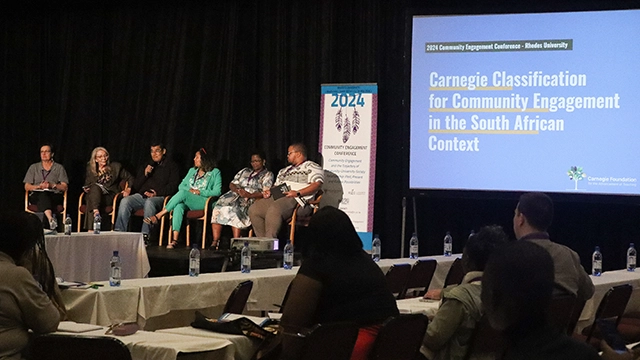
Developing a national framework to measure the effectiveness of community engagement and its contribution to transformation and socio-economic progress in Higher Education Institutions can contribute significantly to the positioning of CE. After years of discussion among practitioners in South Africa over the years, Universities South Africa (USAf) convened a task team to explore developing a classification system that is deeply rooted in local contexts. This system is based on the Carnegie Elective Classification for CE that emerged from the global North. Members of this task team participated in a panel at the Rhodes 老虎机游戏_pt老虎机-平台*官网 Community Engagement Conference to bring the discussion to the broader CE community.
The panel discussion, ‘Carnegie Elective Classification for Community Engagement in the South African Context’ took place in May, featuring Dr. Phethiwe Matutu, CEO of USAf; Prof. Darren Lortan, Chairperson of the South African Higher Education Community Engagement Forum (SAHECEF) and International Association for Research on Service-Learning and Community Engagement (IARSLE); Dr. Marisol Morales, Executive Director of Carnegie Elective Classifications; Ms. Bibi Bowman, Director of Sustainability and Community Impact at North West 老虎机游戏_pt老虎机-平台*官网; and Ms. Diana Hornby, Director of Community Engagement at Rhodes 老虎机游戏_pt老虎机-平台*官网.
The panellists explored how the Carnegie system can be contextualised locally in order to provide a framework for CE in SA. As delegate of the Conference, Joseph Radebe noted, “This is the area where we are struggling to tie the knots, and this is the essence of why we are here and the centre of discussion. Let's dwell more on this framework which we are establishing, and let's give it meat.”
In 2009, SAHECEF was formed and adapted a framework for South African institutions for CE, making a first move toward a formal classification system. Currently, universities in South Africa develop their own strategies for assessing the impact of community engagement activities. For example, Bowman explained how North West 老虎机游戏_pt老虎机-平台*官网 combines high-level goals with grassroots actions to assess the impact of their initiatives. Hornby noted that at RUCE, monitoring and evaluation is used to ensure the division runs data-driven and reflective programmes.
How the Adaptation process emerged
Dr Morales began engaging with South African Community Engagement around classification systems in 2015 at the first Community Engagement Symposium, beginning the discussions on formalising classification of CE in SA. Seven years later, Morales presented a keynote address at the 2023 Community Engagement Learning Symposium. She then approached Dr Matutu about the possibility of developing this framework for the South African context. Dr Matutu then convened a task team and Prof Lortan was appointed as the Chairperson. The task team also includes Dr Amanda Hlengwa, Prof Vhonani Netshandama, Dr Jaqueline Scheepers-Searle, Dr Nthabi Taole-Mjimba and Prof Craig Vincent Lambert.
Adapting before Adopting
Lortan asserts that “should SA and its Universities opt to participate in this framework study, these universities would need to exercise prudence and guard against the potential for subtle colonial regress…If we go into this, the adaptation needs to be thorough. We need to make sure that the context is ours, and within our context, this is what we think should be happening,” says Lortan.
He further highlighted that CE is an unfunded mandate for universities, and the implications of this for sustained CE initiatives and the proposed CE framework. “If the participation becomes contingent upon funding, the benefits may deepen the divide between the divide CE-haves and CE-have nots, as HEIs may deem the cost of participation to be affordable to some and others may decide that the exercise is prohibitively expensive.“
Dr Matutu suggests that whatever classification model is piloted, it will need to be approached at the highest level of the institution. This is necessary to ensure that after evaluation of CE programmes, there is commitment to the improvement.

Photo credit: Andrea Cole
